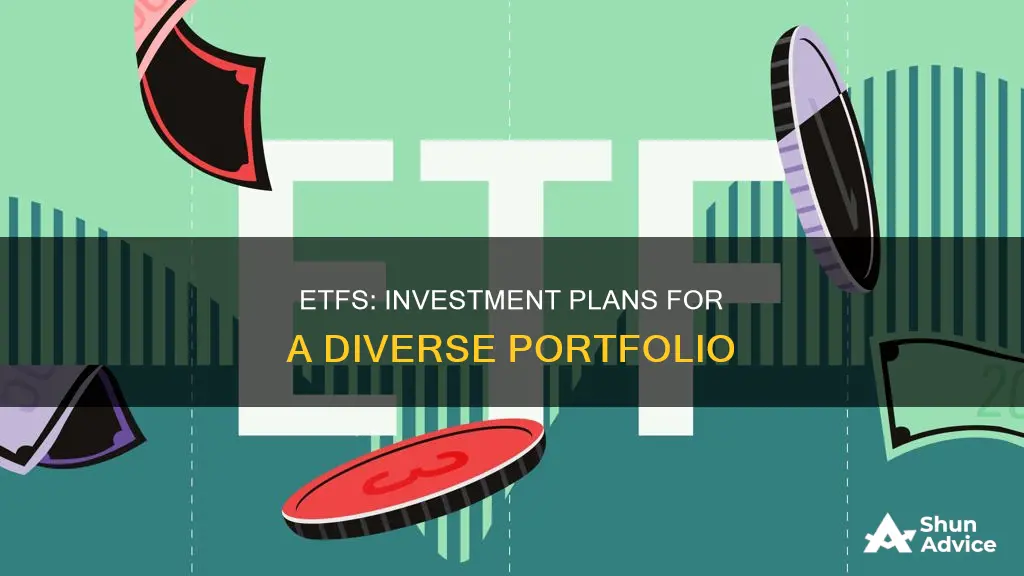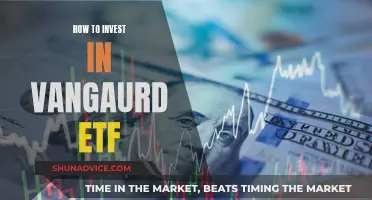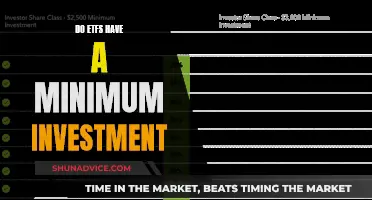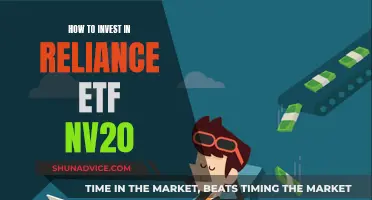
Exchange-Traded Funds (ETFs) are a type of investment vehicle that pools together a group of securities into a fund, which can then be traded like an individual stock on an exchange. ETFs are bought and sold in the same way as stocks, with their prices fluctuating throughout the day as they are bought and sold. They are a popular investment choice due to their low expense ratios, easy diversification, and tax efficiency.
What You'll Learn

ETFs vs mutual funds
Exchange-traded funds (ETFs) and mutual funds are similar in many ways. Both are professionally managed collections or "baskets" of individual stocks or bonds, providing instant access to a wide variety of investment options, including international markets and commodities. They are also less risky than investing in individual stocks and bonds.
However, there are some key differences between the two. ETFs are bought and sold like stocks on a stock exchange, with prices fluctuating throughout the day. Mutual funds, on the other hand, can only be purchased at the end of each trading day and are executed at a single price. ETFs are also more tax-efficient than mutual funds, as they may have lower turnover and can use the in-kind creation/redemption process to manage the cost basis of their holdings.
When it comes to investment minimums, ETFs offer more flexibility as they can be purchased for the price of a single share. Mutual funds, on the other hand, typically have a flat dollar amount as their minimum investment requirement.
ETFs are usually passively managed, tracking a market index or sector sub-index. In contrast, mutual funds are often actively managed, with fund managers making decisions about how to allocate assets. Actively managed funds tend to have higher fees and expense ratios due to their higher operations and trading costs.
In summary, ETFs provide intra-day liquidity and are a good choice for active traders, while mutual funds offer a simpler, more hands-off approach with a fixed investment amount. ETFs are also more tax-efficient and provide more flexibility in terms of investment minimums, but mutual funds may provide a wider range of investment options and are suitable for those who want to invest a fixed dollar amount regularly.
Understanding ETF Holdings: What's in Your Investment?
You may want to see also

Passive vs active ETFs
Exchange-traded funds (ETFs) are a type of investment vehicle that pools a group of securities into a fund, which can then be traded like an individual stock on an exchange. ETFs can be structured to track anything from the price of a commodity to a large and diverse collection of securities.
Passive ETFs
Passive ETFs aim to replicate the performance of a broader index, such as the S&P 500 or a more specific targeted sector or trend. They are designed to track an index in order to provide a return. Passive ETFs tend to follow a buy-and-hold strategy and are often associated with a long-term investment approach. They tend to have lower fees and are more transparent than active ETFs. Passive ETFs are also known for their cost-efficiency and generally have lower management fees.
Active ETFs
Active ETFs, on the other hand, do not target an index of securities. Instead, they involve fund managers making decisions about which securities to include in the portfolio, with the goal of outperforming a benchmark. Active ETFs are designed to not just mirror an index but to potentially beat its market performance. Active fund managers and analysts buy and sell stocks based on their own research and experience, selecting only those stocks they believe have the potential to beat the market. Active ETFs tend to have higher management expenses compared to passive ETFs, as the fund's assets are actively managed with the goal of outperforming the benchmark.
ETFs Delisting: What Happens to Your Investments?
You may want to see also

ETF expense ratios
Exchange-traded funds (ETFs) are a type of investment vehicle that pools a group of securities into a fund. ETFs can be traded like an individual stock on an exchange.
ETFs have operating expense ratios (OERs) for managing the fund and trading costs like commissions and bid/ask spreads that affect returns. The OER is incurred while owning the ETF and is an annual rate that the fund charges on the total assets it holds to pay for portfolio management, administration, and other costs. The OER is relevant for all investors but is particularly important for long-term, buy-and-hold investors.
Even though ETFs can be relatively inexpensive, investing in them includes certain costs. The most obvious is the OER, but trading costs are also important. Commissions (if applicable), bid/ask spreads, and changes in discounts and premiums to an ETF's net asset value (NAV) will all impact the total cost of ownership.
ETFs with lower expense ratios and lower trading costs typically offer better value to investors, as higher expense ratios and/or steeper trading costs may significantly erode returns over time. When selecting an ETF, it is important to compare its expense ratio to the expense ratio of other funds, especially funds that track the same market index or provide exposure to the same type of assets.
The expense ratio of an ETF is typically expressed as a percentage of a fund's average net assets and can include various operational costs and annual fees. For example, if you invest $10,000 in an ETF with an expense ratio of 0.04%, you will pay $4 to the fund's manager that year. As the value of your investment grows, the amount you pay will also grow, which is why a fund's expense ratio can significantly impact your returns over time.
The average expense ratio for index ETFs is typically lower than that of index mutual funds. Actively managed ETFs tend to have higher expense ratios than passive, index-tracking funds. ETFs' average expense ratios have been falling for many years. From 2008 to 2023, average index equity ETF expense ratios declined by 15%, and average index bond ETF expense ratios fell by 30%.
When considering the cost of an ETF, it is important to evaluate not only the expense ratio but also the fund's total cost of ownership (TCO), which includes trading and holding costs. Depending on your rebalancing size and frequency, trading costs can accumulate significantly and have a larger impact on TCO than any expense ratio difference between two ETFs.
BlackRock ETF: A Guide to Investing in Their Funds
You may want to see also

ETF investment strategies
Exchange-traded funds (ETFs) are a great way to build a diverse portfolio with a relatively small amount of money. They are a cost-effective way to invest in multiple securities at once while maintaining the liquidity of owning individual stocks.
- Index ETFs are a simple way to invest in broad segments of the stock, bond, real estate, and commodities markets. They follow a large stock index such as the S&P 500 or the Bloomberg U.S. Aggregate Bond Index.
- Multi-asset ETFs include a mix of stocks, bonds, real estate, or cash within a single fund. The fund managers decide how much to invest in each asset type based on your investment goal.
- Style and Factor ETFs allow you to invest based on your preferred investment style. For example, you can invest in ETFs that track the CRSP small-cap value stock index or focus on companies with strong balance sheets or an upward price trend.
- Sector and Industry ETFs allow you to align your holdings with different sectors of the economy and specific industries within those sectors, such as e-commerce or energy.
- International ETFs allow you to capitalise on growth opportunities in different countries and regions. The largest international ETF tracks the FTSE index of developed countries outside the U.S.
- Socially Responsible ETFs focus on companies that support environmental, social, and governance (ESG) issues. There are about 150 of these ETFs available on U.S. markets.
- Risk Management ETFs help you hedge against downward-moving markets. Inverse ETFs show gains when an index is down and losses when it is up.
- Leveraged ETFs are designed to deliver a multiple of an index return daily and are suitable for experienced investors.
Fertilizer ETF: A Guide to Investing in Agriculture's Future
You may want to see also

ETF pros and cons
Exchange-Traded Funds (ETFs) are a type of investment vehicle that pools securities into a fund that can be traded like an individual stock on an exchange. They are a popular investment option due to their low costs and diversification benefits. Here are some of the key pros and cons of ETFs:
Pros:
- Lower Costs and Fees: ETFs typically have lower operating expense ratios (OERs) than actively managed mutual funds, as they are passively managed and do not incur active trading costs.
- Tax Efficiency: ETFs are considered more tax-efficient than mutual funds as they realise fewer capital gains due to their passive nature, resulting in lower tax burdens for investors.
- Diversification: ETFs provide access to a diverse mix of asset classes, including domestic and international stocks, bonds, and commodities, helping to lower investment risk.
- Flexibility and Liquidity: ETFs can be traded throughout the day, offering flexibility and liquidity. They can also be purchased on margin and sold short.
- Accessibility: ETFs are widely accessible to investors, providing instant access to international markets and commodities.
Cons:
- Limited Diversification: Some ETFs, particularly those focused on specific sectors or foreign stocks, may offer limited diversification by only including large-cap stocks. This could result in missed growth opportunities.
- Intraday Pricing Risks: Intraday pricing movements might induce unnecessary trading for longer-term investors, as short-term price swings could prompt emotional trading decisions.
- Higher Costs for Certain Investments: While ETFs generally have lower costs, for certain niche or specialised investments, the costs of investing in an ETF might be higher than investing directly in the underlying stocks.
- Lower Dividend Yields: While there are dividend-paying ETFs, the yields may be lower than those obtained by owning individual high-yield stocks.
- Shutdown Risk: ETFs carry a minor risk of shutting down, which could result in unexpected capital gains taxes and fees for investors.
- Complexities and Risks: The most speculative varieties of ETFs may carry complexities and risks that investors should carefully evaluate before investing.
Overall, ETFs offer a range of benefits, including lower costs, tax efficiency, and diversification. However, investors should also be aware of the potential drawbacks, such as limited diversification, higher costs for certain investments, and the risks associated with intraday pricing and speculative varieties of ETFs.
Hedged vs Unhedged ETFs: Which Investment Option is Better?
You may want to see also
Frequently asked questions
An ETF, or Exchange-Traded Fund, is a financial product that allows investors to buy a bundle of assets, such as stocks, bonds, commodities, etc., which can be traded on a stock exchange. ETFs are an affordable way to access a wide variety of asset classes and are known for their flexibility and portfolio diversification.
ETFs are bought and sold like common stocks on a stock exchange. They are traded during regular market hours and experience price changes throughout the day. The value of an ETF share is determined by the demand for it and the net asset value of its underlying components.
ETFs offer several advantages, including:
- Low costs: ETFs typically have lower operating expense ratios (OERs) than actively managed mutual funds, making them a cost-effective way to invest in a diverse range of assets.
- Tax efficiency: ETFs are considered more tax-efficient than mutual funds as they generate a lower level of capital gain distributions.
- Diversification: ETFs provide access to a wide range of asset classes, sectors, and geographies, helping investors spread their risk.
- Easy access: ETFs can be easily bought and sold through online brokers or investment platforms, providing instant access to international markets.
While ETFs offer numerous benefits, there are also some risks to consider:
- Volatility: As ETFs invest in a diverse range of assets, their value can fluctuate, and you may get back less than your initial investment.
- Tracking difference: Even after accounting for charges, ETFs may not perfectly mirror the performance of the index they track.
- Illiquidity: Some thinly traded ETFs have wide bid-ask spreads, which can impact the price at which you buy and sell.
- Other costs: ETFs are subject to expense ratios and potential commission fees per trade, so it's important to consider all costs before investing.







